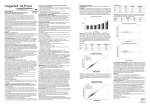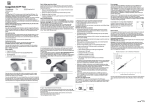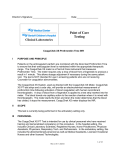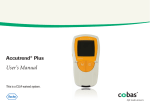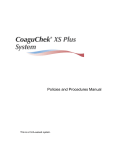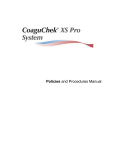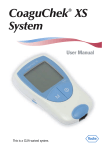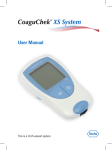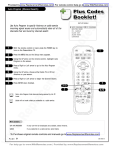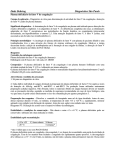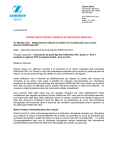Transcript
CoaguChek XS PT Test ® 04625315160 FOR USE WITH THE COAGUCHEK XS PRO SYSTEM 48 Test Strips 1 Code Chip Purpose The CoaguChek XS Pro System is intended for use by professional healthcare providers for quantitative prothrombin time testing for monitoring warfarin therapy. The CoaguChek XS Pro System uses fresh capillary or non-anticoagulated venous whole blood. The term "System(s)" hereafter will refer to both the CoaguChek XS Pro System and the CoaguChek XS Plus System. Caution: For in vitro diagnostic use. Before You Start Testing If you are new to the CoaguChek XS Pro System, watch the CoaguChek XS Pro System Training DVD and read the CoaguChek XS Pro System Getting Started Guide and CoaguChek XS Pro System User Manual. Read the CoaguChek XS Pro PT Controls package insert and this entire insert. Storing the Test Strips Store the test strips in their original container, with the cap closed. You can store the test strips at room temperature or in the refrigerator (2-30 °C or 36-86 °F). When stored properly, the test strips can be used until the expiration date printed on the test strip container. Discard the test strips if they are past the expiration date on the container. Handling the Test Strips When you are ready to test, open the test strip container and remove 1 test strip. Immediately close the container. Make sure it seals tightly. IMPORTANT: Do not open a container of test strips or touch a test strip with wet hands or wet gloves. This may damage the test strips. You must use the test strip within 10 minutes of removing it from the container. Otherwise, you may get an error message, and you will have to repeat the test. Sample Collection and Preparation The steps that follow apply to collecting a blood sample from a fingerstick. Optionally, you may use a nonanticoagulated plastic capillary tube to collect the fingerstick blood sample. You may also use the CoaguChek XS Pro System to test venous blood. See the CoaguChek XS Pro System User Manual for more information. When collecting any type of sample, follow universal blood collection precautions and guidelines. Step 1: Getting Ready to Test Gather supplies: • CoaguChek XS Pro Meter • CoaguChek XS PT Test Strip and Test Strip Code Chip 04348150001 Follow manufacturer’s instructions for use. If • CoaguChek Lancet you are using test strips from a new, unopened container, you must change the Test Strip Code Chip. The three-number code on the test strip container must match the three-number code on the code chip. To install the code chip, follow the instructions in the Code Chip section of the User Manual. Place the meter on a flat surface (like a table or countertop) or hold it roughly horizontal so that it will not vibrate or move during testing. Vibrations or other movement can result in an error message. Step 2: Getting a Good Drop of Blood Increasing the blood flow in the finger will help you get a good drop of blood. Before you lance the finger, try the following techniques until you see that the fingertip has increased color. • Warm the hand by having the patient hold it under his or her arm, use a hand warmer, and/or wash the hand with warm water. • Have the patient hold his or her arm down to the side, so hand is below waist. • Massage the finger from its base. • If needed, immediately after lancing, gently squeeze the finger from its base to encourage blood flow. Step 3: Performing the Test 1. Wash the patient’s hands with warm, soapy water or wipe the finger with alcohol. Dry the patient’s hands completely. Make sure your hands and gloves are dry before proceeding. 2. When you are ready to test, remove 1 test strip from the container and immediately close the container. Make sure it seals tightly. Do not open a container of test strips or touch a test strip with wet hands or wet gloves. This may damage the test strips. 3. Insert test strip as far as you can into the meter. This powers the meter ON. 4. Press Patient Test on the meter display. The meter warms the test strip. Then the meter begins a countdown. You have 180 seconds to apply a blood sample to the test strip. If your facility procedures require use of the Operator ID, Patient ID, and the barcode scanner, refer to the User Manual. 5. The meter automatically checks to see if you have the right Test Strip Code Chip. The three-number code on the test strip container must match the threenumber code on the code chip before the test can be run. If you are using test strips from a new, unopened container, you must change the Test Strip Code Chip. 6. Use a CoaguChek lancet to perform a fingerstick. 7. Hold the finger very close to the target area (clear area of the test strip). Apply 1 drop of blood to the top or side of the target area and wait until you hear the beep, if the beeper is enabled. You must apply blood to the test strip within 15 seconds of lancing the finger. 8. Do not add more blood. Do not touch or remove the test strip while the test is in progress. The flashing blood drop symbol changes to an hourglass symbol when the meter detects sufficient sample. 9. The result appears in approximately one minute. Record the result. You may add comments to the test result about the test conditions or the patient. Refer to the User Manual. 10. Properly dispose of the used lancet and test strip. 11. Power the meter OFF. NOTE: If you need to repeat a test, use a new test strip and lancet, and a different finger. Technical Information: How the Test Works The CoaguChek XS PT Test, used as directed with the CoaguChek XS Pro Meter, will provide an electrochemical measurement of prothrombin time following activation of blood coagulation with human recombinant thromboplastin. In simple terms, blood works with the chemicals in the test strip to produce a small electric current in the test strip that measures blood-clotting time. Contents of the Test Strip The test strip contains reagent (human recombinant thromboplastin 1.5 U), as well as stabilizers, preservatives, and additives. Limitations of Procedure • The CoaguChek XS Pro System should not be used for patients being treated with any direct thrombin inhibitors, including Hirudin, Lepirudin, Bivalirudin and Argatroban. • The CoaguChek XS PT Test uses only fresh capillary or non-anticoagulated venous whole blood. Plasma or serum cannot be used. • Use only plastic syringes without anticoagulants or additives. Glass tubes or syringes must not be used. • The blood drop must be a minimum of 8 μL in volume. Low sample volume will cause an error message. • Never add more blood to the test strip after the test has begun or perform another test using the same fingerstick. • When a patient is on intravenous infusion therapy, do not collect the sample from the arm receiving the infusion line. • Hematocrit values between 25-55 % do not significantly affect test results. • Testing performed with the following in vitro spiked samples or native blood samples (triglycerides) indicated no significant effect on test results: • Bilirubin up to 30 mg/dL • Lipemic samples containing up to 500 mg/dL of triglycerides • Hemolysis up to 1000 mg/dL • Heparin concentrations up to 0.8 U/mL. • Low molecular weight heparins (LMWH) up to 2 IU anti-factor Xa activity/mL • Clopidogrel up to 20 mg/dL • Fondaparinux up to 5 mg/L • The presence of anti-phospholipid antibodies (APAs) such as Lupus antibodies (LA) can potentially lead to prolonged clotting times, i.e., elevated INR values. A comparison to an APA-insensitive laboratory method is recommended if the presence of APAs is known or suspected.1 • Is the meter displaying "ERROR 6"? Sporadically occurring ERROR 6 are generally due to an activation of the system fail safe mechanisms that are designed to prevent the release of wrong measurement results. However, in rare cases, "ERROR 6" may be received with patients who are under treatment with warfarin (vitamin K antagonists) in combination with antibiotics and/or chemotherapeutics leading to extremely high coagulation times (>10 INR, <5 % Quick). In this case, and if "ERROR 6" is displayed repeatedly, the result must be checked using another method. • In rare cases, patients with long clotting times ( >8 INR) may receive an “ERROR 7” message on the meter display. If this error message appears again when the test is repeated, the result must be checked using another method. Expected Results The meter displays test results in units equivalent to laboratory plasma measurements. Results may be displayed in three ways: • the International Normalized Ratio (INR=(PT/Mean Normal PT) ISI ) • seconds, and • % Quick (a unit used mainly by healthcare professionals in Europe). Each lot of test strips is calibrated to a reference lot that is traceable to the WHO International Reference Preparations. Normal INR levels vary from person to person. For the purpose of providing universal INR results, the Mean Normal Prothrombin Time (MNPT) has been established as 12 seconds and the International Sensitivity Index (ISI) for the system has been established as 1. The physician must determine the best INR level depending on the reason for anticoagulant treatment and how each individual responds to treatment (based on Prothrombin Time). Each physician should establish expected values for his or her patient population or individual patients. Differences in reagents, instruments, and pre-analytical variables can affect prothrombin time results. These factors should be considered when comparing different prothrombin time test methods.2 Experience comparing results obtained using the Systems to those obtained using common clinical laboratory reagents shows that the Systems correlate well with the following clinical laboratory reagents: Dade Innovin, Ortho Recomboplastin, and Dade Thromboplastin C+. Other clinical laboratory reagents may not consistently correlate with the Systems. Unusual Results If the meter displays an error message, refer to the Error Messages section of the User Manual. If the meter displays an unusual test result (other than an error message), check the following items: • Certain drugs may affect results by interfering with warfarin pharmacology. The potential effect of a drug interaction with warfarin or the effect of underlying diseases (e.g., liver disease, congestive heart failure) must be considered when interpreting a result. • Changes in the patient’s diet can cause unusually low or high results. • Any unusual result should always be followed up with inquiries to define the cause of the unusual result. If the result does not match the clinical symptoms, repeat the patient test to rule out procedural error. Performance Characteristics The following performance characteristics are representative for both CoaguChek XS Pro meter and CoaguChek XS Plus meter. Measuring Range: Each system has a reportable range of 0.8 to 8.0 INR. Sensitivity: The CoaguChek XS PT Test is sensitive to various clotting factors as determined by in vitro tests. Single factor depleted plasma was combined with a normal plasma pool to produce a series of diluted plasma samples. These plasma samples were then tested using three representative lots of the CoaguChek XS PT Test across 16 CoaguChek XS meters. The results, as seen in the graph, represent the typical CoaguChek XS PT Test sensitivity to Factors II, V, VII, and X. Sample N Mean INR SD CV Venous 399 2.32 0.046 2.00 Capillary 399 2.26 0.077 3.39 Accuracy: 811 venous samples were collected from 412 outpatients at three external sites. The INR of each sample was compared to the INR of a venous plasma sample measured on a Dade Sysmex 560 Analyzer using Dade Innovin (ISI = 1.02). The patient clinical conditions included (number of patients): not on warfarin (61), atrial fibrillation (163), valve repair/replacement (44), stroke/TIA (5), DVT (75), pulmonary embolism (22), cardiovascular accident (15), other heartrelated disorders (9), other clotting disorders (13), other (5). The results are as follows: Venous Data: Site 1 N 287 Slope 1.071 Intercept -0.2 Site 2 Site 3 All Correlation 0.969 286 1.091 -0.1 0.975 238 1.111 -0.1 0.983 811 1.090 -0.2 0.974 Dade Innovin INR Accuracy: 822 capillary samples were collected from 413 outpatients at three external sites. Capillary blood samples were assayed on the CoaguChek XS Plus Meter with the CoaguChek XS PT Test and venous samples were measured on a Dade Sysmex 560 Analyzer with Dade Innovin (ISI = 1.02). The results are as follows: Capillary Data: Site 1 N 287 Slope 1.048 Intercept -0.1 Correlation 0.959 Site 2 297 1.071 -0.1 0.974 Site 3 238 1.111 -0.1 0.988 All 822 1.075 -0.1 0.972 Built-In Controls and Diagnostics The CoaguChek XS Pro System has quality control functions integrated into the meter and test strips, so you do not have to run quality control tests with liquid quality controls. A two-level, on-board quality control test is performed within the test chamber as part of every blood test. For more information about the built-in quality control functions, see the CoaguChek XS Pro System User Manual. Roche Diagnostics has available optional liquid quality controls 04625382160 for the CoaguChek XS Pro System. These controls are provided to assist with meeting regulatory compliance requirements, as applicable to your facility. Frequency and necessity of liquid quality control tests are at the discretion of each individual facility. References are listed on the other side of this insert. Additional Information The CoaguChek XS Pro System User Manual contains more information. If you need technical help, call Roche Diagnostics Technical Service Center 1-800-428-4674, 24 hours a day, 7 days a week, 365 days a year. Any adverse reactions experienced with the use of this product, and/or quality problems should also be reported to the FDA’s MedWatch Adverse Event Reporting program online (at www.fda.gov/MedWatch/report.htm), by phone (1-800-FDA-1088), or by returning the postage-paid FDA form 3500 (which may be downloaded from www.fda.gov/MedWatch/getforms.htm) by mail to (MedWatch, 5600 Fishers Lane, Rockville, MD 20852-9787) or fax (1-800-FDA0178). If there are any problems with the CoaguChek XS Pro meter, notify CMS at http://www.cms.hhs.gov/clia/ro-map.asp. Return Policy If there is a problem with the CoaguChek XS PT Test Strips, you may be asked to return them, along with the Test Strip Code Chip, to Roche Diagnostics. Before returning, call Roche Diagnostics Technical Service Center at 1-800-428-4674. You will be mailed a return authorization label which must be placed on the shipping carton. Limited Warranty Roche Diagnostics warrants that this product will meet the specifications stated in the labeling when used in accordance with such labeling and will be free from defects in material and workmanship until the expiration date printed on the label. THIS LIMITED WARRANTY IS IN LIEU OF ANY OTHER WARRANTY, EXPRESS OR IMPLIED, INCLUDING ANY IMPLIED WARRANTY OF MERCHANTABILITY OR FITNESS FOR PARTICULAR PURPOSE. IN NO EVENT SHALL ROCHE DIAGNOSTICS BE LIABLE FOR INCIDENTAL, INDIRECT, SPECIAL OR CONSEQUENTIAL DAMAGES. COAGUCHEK is a trademark of Roche. All other product names and trademarks are the property of their respective owners. Significant additions or changes are indicated by a change bar in the margin. © 2013, Roche Diagnostics Dade Innovin INR Precision: Whole blood precision was determined for venous and capillary blood from sample duplicates collected at three sites. The following results represent whole blood precision for venous and capillary blood. Roche Diagnostics GmbH, Sandhofer Strasse 116, D-68305 Mannheim www.roche.com www.poc.roche.com Distribution in USA by: Roche Diagnostics, Indianapolis, IN US Customer Technical Support 1-800-428-4674 05967716001(04) V1/R1 (black) - 2013-05
